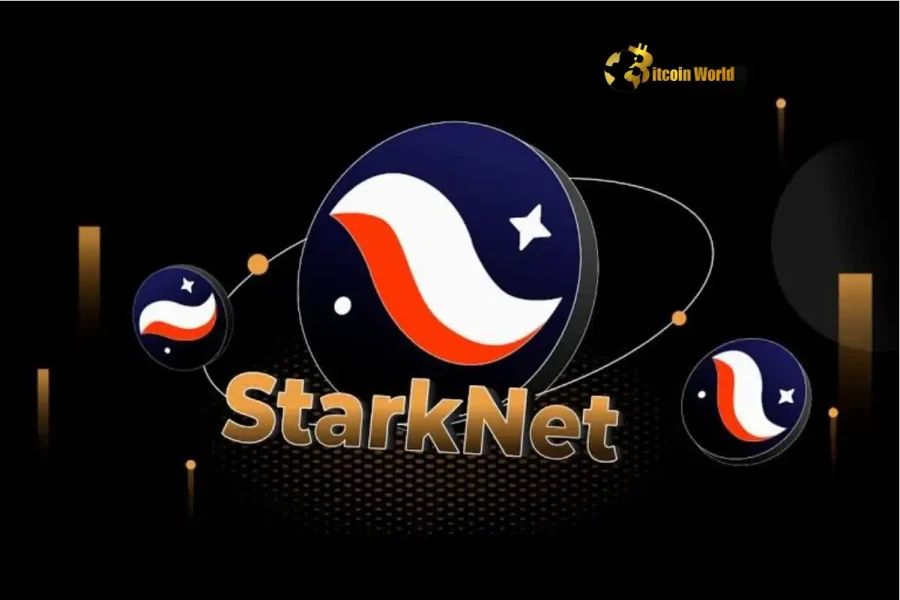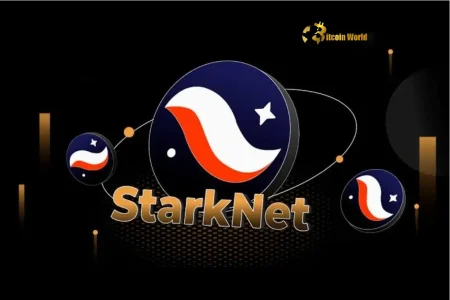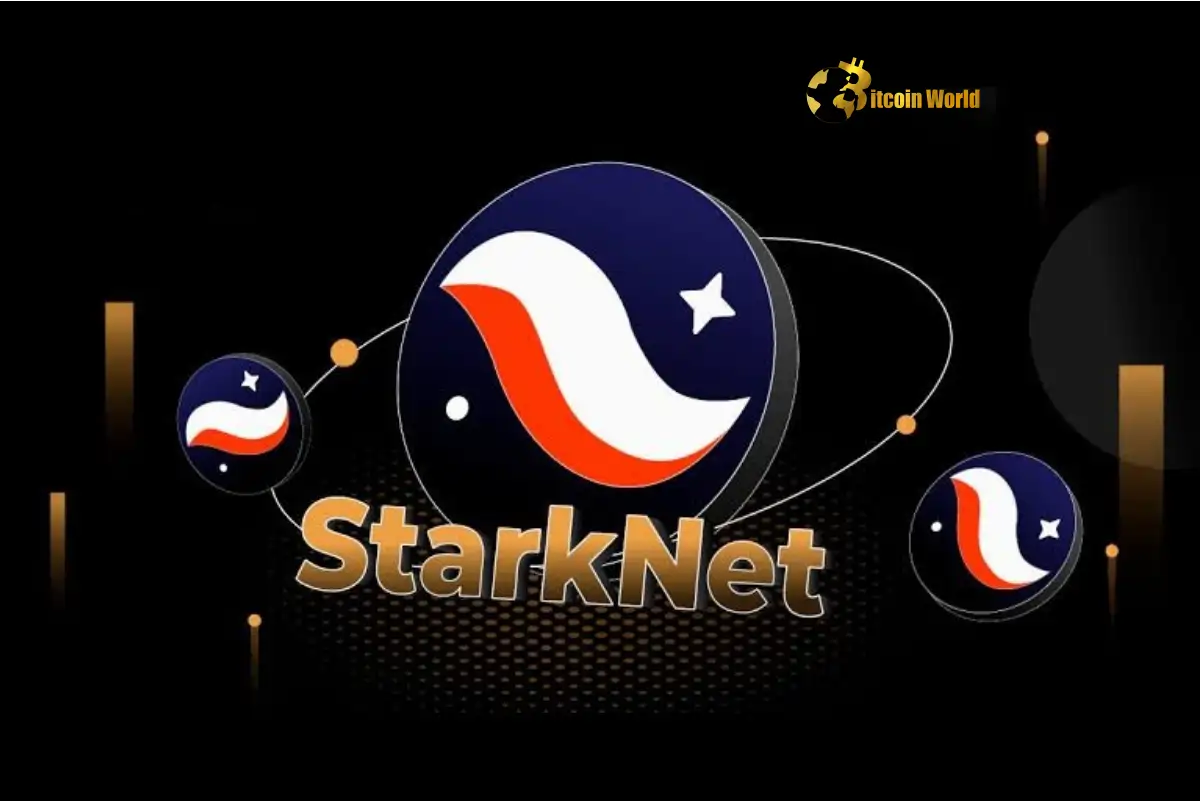Starknet Decentralization: Huge Leap Towards Full Community Governance
0
0


BitcoinWorld

Starknet Decentralization: Huge Leap Towards Full Community Governance
Exciting news from the world of Ethereum Layer 2! Starknet, a leading validity rollup scaling solution, has just hit a major milestone on its journey towards becoming fully decentralized. This isn’t just technical jargon; it’s a significant step that impacts the security, resilience, and future direction of the network, bringing it closer to true community control.
According to reports, Starknet has officially achieved Stage 1 decentralization. This achievement is benchmarked against a well-known framework for rollup decentralization proposed by Ethereum co-founder Vitalik Buterin back in 2022. Reaching Stage 1 means Starknet has implemented crucial mechanisms that move it beyond a centralized operational model, laying the groundwork for a more robust and community-driven future. It’s a big deal for Starknet decentralization.
What Does Stage 1 Decentralization Mean for Starknet?
Understanding Starknet’s achievement requires looking at the framework it’s using. Vitalik Buterin‘s “training wheels” model outlines a clear path for rollups to progressively decentralize. Think of it like a phased approach, where the network gradually removes dependencies on a central team and transfers control and security responsibilities to broader, decentralized mechanisms.
The framework includes three main stages:
- Stage 0 (Centralized): This is the initial phase where the rollup’s operation, upgrades, and security often rely heavily on the core development team. Users might need to trust the operator not to act maliciously.
- Stage 1 (Partially Decentralized): At this stage, the network implements key security and governance mechanisms that provide users with recourse or protection against potential operator failures or malicious actions. While some central control might still exist, decentralized checks and balances are in place.
- Stage 2 (Fully Decentralized): The ultimate goal. In this stage, the network is entirely controlled by decentralized governance mechanisms, typically involving token holders or a decentralized autonomous organization (DAO). Upgrades, security, and protocol parameters are managed by the community.
By reaching Stage 1, Starknet has demonstrated that it has successfully implemented the necessary components to move past the initial centralized phase, offering enhanced security and reliability to its users and the broader Ethereum Layer 2 ecosystem.
How Did Starknet Achieve This Milestone?
Starknet didn’t just flip a switch; reaching Stage 1 involved implementing several critical components. These additions are designed to increase the network’s resilience and reduce reliance on a single entity. Key elements include:
1. The Launch of a Security Council:
A significant step towards Starknet governance involves the establishment of a Security Council. This council is composed of reputable and independent members from the community and the wider blockchain ecosystem. Their primary role is to act as a check on the system, particularly concerning security-sensitive operations like protocol upgrades or emergency situations. In a Stage 1 rollup, such a council can provide a decentralized layer of oversight, ensuring that critical decisions are not solely in the hands of the core development team. This adds a layer of trust and safety for users interacting with the scaling solution.
2. Implementation of Censorship-Resistance Mechanisms:
A core principle of blockchain is censorship resistance – the ability for users to transact freely without a central authority blocking or interfering with their operations. For a rollup, this means ensuring that users can always withdraw their funds back to the main Ethereum chain, even if the rollup operator is unresponsive or malicious. Stage 1 requires robust mechanisms to guarantee this. Starknet has put in place systems that allow users to force transactions or withdrawals directly through the L1 Ethereum contract, bypassing the L2 operator if necessary. This is vital for user confidence and reinforces the decentralized nature of the network, strengthening Starknet decentralization.
3. A Smart Contract-Based Validity Proof System:
As a validity rollup, Starknet relies on STARK proofs to verify the correctness of transactions processed off-chain before settling them on Ethereum L1. Achieving Stage 1 means the system for verifying these proofs on Ethereum is robust and accessible. The smart contract on Ethereum L1 that verifies the proofs acts as the ultimate arbiter of the L2 state. For Stage 1, this system must be reliable and able to handle proof verification correctly. This foundational technology is key to Starknet’s operation as a secure scaling solution.
These components work together to build a more resilient and trustworthy network. While the core team might still be responsible for proposing upgrades, the Security Council and the ability for users to interact directly with L1 provide decentralized checks and balances required for Stage 1 under the Vitalik Buterin framework.
Why is Decentralization Crucial for Ethereum Layer 2s?
You might wonder, why is all this decentralization effort necessary? Isn’t scaling the main goal? While scaling is paramount, decentralization is equally vital for several reasons:
- Security: A decentralized network is inherently more secure. There’s no single point of failure that can be attacked or compromised. Control is distributed, making the system more robust against malicious actors. This is fundamental for any reliable Ethereum Layer 2.
- Censorship Resistance: As mentioned earlier, decentralization ensures that no single entity can prevent legitimate transactions or block users from accessing their funds. This aligns with the core ethos of blockchain technology.
- Trust Minimization: In a decentralized system, users don’t have to place blind trust in a central operator. The security and rules are enforced by code and distributed consensus, reducing the need for trust in human operators. This is a major benefit of achieving true Starknet decentralization.
- Community Ownership and Governance: Ultimately, decentralization paves the way for true community governance. This allows users, developers, and token holders to have a say in the network’s future development, upgrades, and parameter changes, leading to a more democratic and community-aligned network. This is the goal of full Starknet governance.
- Resilience: Decentralized networks are more resilient to outages, political pressure, or regulatory interference targeting a single company or team.
Reaching Stage 1 is a public declaration that Starknet is serious about these principles and is actively building towards a future where the network is truly owned and controlled by its community, not just the founding team. This strengthens its position as a reliable scaling solution.
What’s Next? The Path to Stage 2 and Beyond
Achieving Stage 1 is a significant milestone, but it’s not the end of the journey for Starknet decentralization. The stated goal is to reach Stage 2—full community governance.
Moving from Stage 1 to Stage 2 typically involves transferring more control over critical functions to decentralized governance mechanisms. This might include:
- Allowing the community (via token voting or other mechanisms) to propose and approve protocol upgrades.
- Decentralizing the sequencing and proving of transactions.
- Granting the community control over treasury funds or protocol parameters.
The exact steps and timeline for Starknet to reach Stage 2 will depend on their development roadmap and community engagement. It’s a complex process that requires careful planning and execution to ensure the network remains secure and efficient while transitioning control.
Beyond the core goal of full decentralization, Starknet is also looking to expand its horizons. The article mentions their development towards Bitcoin. This suggests potential future integrations or expansion of Starknet’s technology and ecosystem to leverage or interact with the Bitcoin network. This could open up new possibilities for decentralized finance (DeFi) and other applications across different major blockchain networks, further solidifying its role as a versatile scaling solution.
Benefits of Starknet’s Progress for Users and Developers
This move towards greater decentralization brings tangible benefits:
For Users:
- Increased Security: Reduced reliance on a central operator means less counterparty risk.
- Enhanced Censorship Resistance: Greater assurance that you can always access and move your funds.
- Greater Trust: The system is secured by decentralized mechanisms rather than a single team.
- Future Voice: As Starknet governance evolves, users holding tokens may gain the ability to participate in decisions affecting the network they use.
For Developers:
- More Stable Platform: A decentralized network is less susceptible to abrupt changes or failures controlled by a single entity.
- Clearer Roadmap: Progress towards decentralization provides a clearer long-term vision for the platform.
- Community Collaboration: Future decentralized governance can allow developers to propose and contribute to the protocol’s evolution in a more open manner.
This progress makes Starknet an increasingly attractive platform within the competitive landscape of Ethereum Layer 2 solutions.
Are There Challenges on the Path to Full Decentralization?
Absolutely. The journey to full decentralization (Stage 2) is not without its hurdles. Some potential challenges include:
1. Governance Complexity: Designing and implementing effective decentralized governance mechanisms that are secure, efficient, and encourage broad participation is challenging. Poorly designed governance can lead to inaction or vulnerability.
2. Technical Decentralization: Decentralizing components like the sequencer (which orders transactions) or provers (which generate validity proofs) is technically complex and requires innovative solutions to maintain performance and security.
3. Security Risks During Transition: Moving from a more centralized to a decentralized model requires careful auditing and phased rollouts to avoid introducing new vulnerabilities.
4. Community Engagement: Achieving true Starknet governance requires an active and informed community willing to participate in the decision-making process.
Starknet’s team and community will need to navigate these challenges carefully to successfully reach Stage 2 and maintain the network’s health and security. Their progress to Stage 1, however, shows a commitment to tackling these complex issues head-on.
Actionable Insights for the Community
For users and developers interested in Starknet and the future of Ethereum Layer 2 scaling solutions, this milestone offers several insights:
- Stay Informed: Follow Starknet’s official channels and community forums to keep up with further decentralization updates and governance proposals.
- Engage with Governance: As governance mechanisms evolve, consider participating if you hold STRK tokens or are involved in the ecosystem. Your voice can help shape the future of Starknet governance.
- Understand the Framework: Familiarize yourself with the Vitalik Buterin rollup stages to better evaluate the decentralization progress of different L2s.
- Explore the Ecosystem: With increasing decentralization comes greater stability and trust, making it a good time to explore dApps building on Starknet.
Compelling Summary: A Major Step Forward
Starknet’s achievement of Stage 1 decentralization is a genuinely significant event for the network and the wider blockchain space. By implementing a Security Council, censorship-resistance measures, and a robust validity proof system, Starknet has demonstrated concrete progress in moving away from centralized control, aligning itself with the principles outlined in Vitalik Buterin‘s framework. This milestone enhances the network’s security, resilience, and trustworthiness as an Ethereum Layer 2 scaling solution.
While the path to full Stage 2 decentralization and complete community-driven Starknet governance is still ongoing and presents its own set of challenges, reaching Stage 1 is a powerful indicator of Starknet’s commitment to building a truly decentralized future. This progress, coupled with ambitions to expand towards Bitcoin, positions Starknet as a key player to watch in the evolution of blockchain scaling solutions.
To learn more about the latest Ethereum Layer 2 scaling solutions and trends, explore our articles on key developments shaping the future of Starknet governance.
This post Starknet Decentralization: Huge Leap Towards Full Community Governance first appeared on BitcoinWorld and is written by Editorial Team
0
0
 Manage all your crypto, NFT and DeFi from one place
Manage all your crypto, NFT and DeFi from one placeSecurely connect the portfolio you’re using to start.







